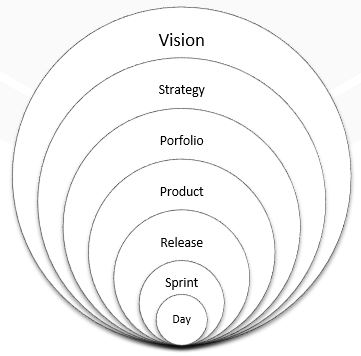 Product Owner Role
Product Owner Role
Chooses the right things.
The Product Owner role is a key role responsible for the ROI of the product. He is the father of the product. Typically it is somebody close to the business, or somebody who can represent it.
In the case of large teams, the role of the Product Owner needs to be aligned with the Chief Product Owner role.
The product owner is a member of an agile team from the product perspective. The team and the product owner are in the same boat. Together they are responsible and accountable to deliver the right product made in the right way.
Capabilities of the great product owner
- Leader & motivator.
- Great in communication with clients and teams as well.
- Able to specify product strategy and describe requirements.
- Knowledge of the business.
- Product management experience.
- Project management fundamentals.
- Entrepreneurship in blood.
An influence of the product owner
The product owner thinks on multiple levels. These levels are considered very often in parallel time as the product owner should not be focused just on the current sprint. She must be prepared and prepare for the future. More than the current sprint.

The product owner works in multiple “timezones”.
- In the current sprint, PO helps to solve risks, answer questions from the team and stakeholders, and accept requirements implemented by the team.
- In parallel, he provides details for requirements prepared for the next sprint with a project manager, UX designer, architects and some senior developers. With anybody who can be helpful to get requirements ready.
- In parallel, the next version is planned. The next Minimum Viable Product is discussed with key stakeholders, customers, and selected users.
Responsibilities of the product owner role
- Product vision.
- Strategy for product development and delivery.
- Cooperation and communication with clients, stakeholders and product users. Description of the users with help of value proposition canvas and personas.
- Close collaboration with the development team(s).
- Synchronization with other product owners in case the product is developed by multiple teams.
- An identification of the business value used for prioritization, e.g. business model canvas, lean canvas.
- Identification of business themes that the product should support in a given time.
- Management of requirements. Break down of requirements (features, epics, user stories).
- He assures that team understands requirements with help of acceptance criteria.
- Setting up an order of requirements.
- Backlog management in electronic or physical tools.
- Roadmaps and releases.
- Provides feedback to the team.
- The product owner signs the results!
What Product owner role needs for his work
- 100% allocation of the product. Ok, 75% at least. You will see it is the correct value.
- Full power & trust for decisions.
- Availability for team & clients. Personal communication is preferred.
- A great team that takes care of the product and the results.
- Be able to ask for forgiveness, not permission.
- Be able to work on the right things, not just urgent things.
Typical mistakes of the product owner
- Does not provide enough details for requirements.
- Inconsistent requirements.
- Not targeting the vision.
- No sprint goal.
- Not participating actively in the backlog grooming and preparation of sprints.
- Not thinking in larger timeboxes – product increments (3-4 sprints).
- A product strategy is not agreed with stakeholders.
- Missing qualitative communication with either the team or stakeholders.
- Activities not coordinated with ScrumMaster.
- Activities not synchronized with other product owners, the chief product owner, project and line management.
- The product owner does not connect the team & clients.
Product Owner’s circle
Sometimes, all necessary activities can’t be done by the product owner. In such a case, the product owner needs the support of other team members (consultants, analysts, project managers,…). The product owner is accountable. See RACI matrix.

